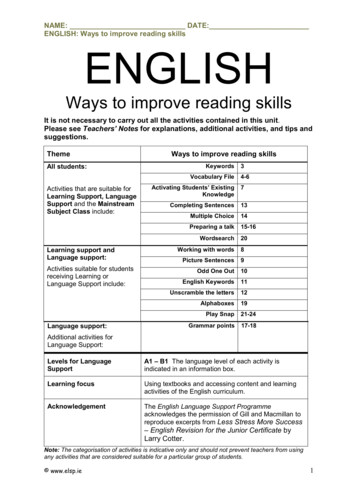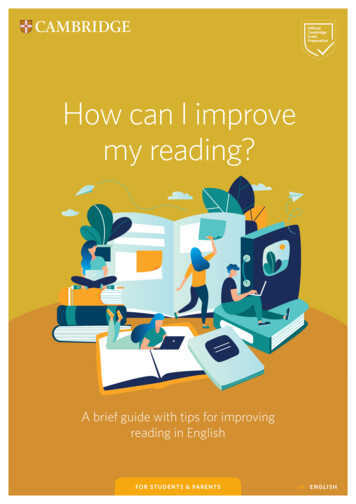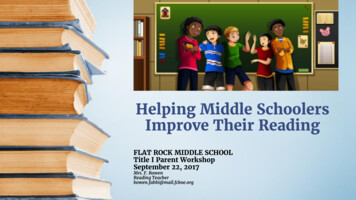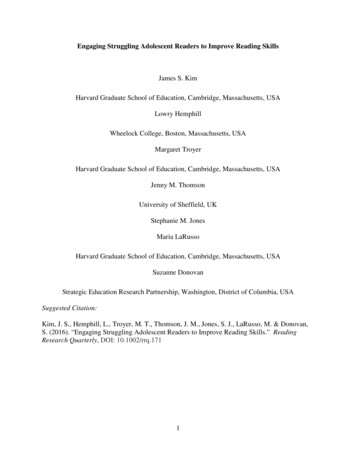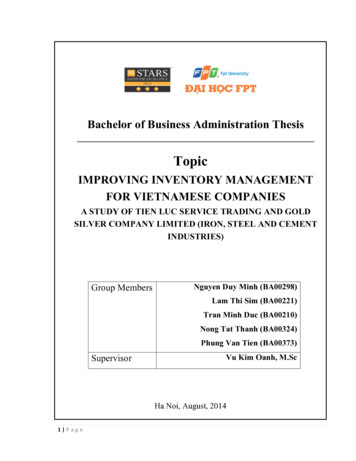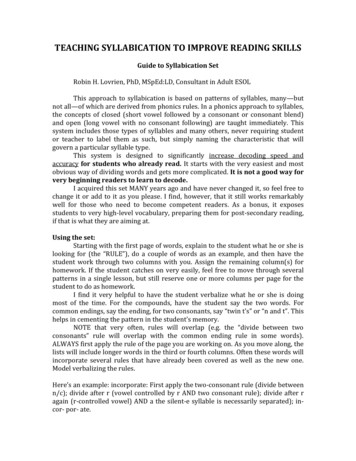
Transcription
TEACHING SYLLABICATION TO IMPROVE READING SKILLSGuide to Syllabication SetRobin H. Lovrien, PhD, MSpEd:LD, Consultant in Adult ESOLThis approach to syllabication is based on patterns of syllables, many—butnot all—of which are derived from phonics rules. In a phonics approach to syllables,the concepts of closed (short vowel followed by a consonant or consonant blend)and open (long vowel with no consonant following) are taught immediately. Thissystem includes those types of syllables and many others, never requiring studentor teacher to label them as such, but simply naming the characteristic that willgovern a particular syllable type.This system is designed to significantly increase decoding speed andaccuracy for students who already read. It starts with the very easiest and mostobvious way of dividing words and gets more complicated. It is not a good way forvery beginning readers to learn to decode.I acquired this set MANY years ago and have never changed it, so feel free tochange it or add to it as you please. I find, however, that it still works remarkablywell for those who need to become competent readers. As a bonus, it exposesstudents to very high-level vocabulary, preparing them for post-secondary reading,if that is what they are aiming at.Using the set:Starting with the first page of words, explain to the student what he or she islooking for (the “RULE”), do a couple of words as an example, and then have thestudent work through two columns with you. Assign the remaining column(s) forhomework. If the student catches on very easily, feel free to move through severalpatterns in a single lesson, but still reserve one or more columns per page for thestudent to do as homework.I find it very helpful to have the student verbalize what he or she is doingmost of the time. For the compounds, have the student say the two words. Forcommon endings, say the ending, for two consonants, say “twin t’s” or “n and t”. Thishelps in cementing the pattern in the student’s memory.NOTE that very often, rules will overlap (e.g. the “divide between twoconsonants” rule will overlap with the common ending rule in some words).ALWAYS first apply the rule of the page you are working on. As you move along, thelists will include longer words in the third or fourth columns. Often these words willincorporate several rules that have already been covered as well as the new one.Model verbalizing the rules.Here’s an example: incorporate: First apply the two-consonant rule (divide betweenn/c); divide after r (vowel controlled by r AND two consonant rule); divide after ragain (r-controlled vowel) AND a the silent-e syllable is necessarily separated); incor- por- ate.
Remember: EVERYONE makes mistakes!! Practice yourself, then do the best youcan.Also note that this system will not always align with dictionary divisions of rules .SYLLABLE RULES AND PAGES:Page 2: RULE: Divide between two words in a compound wordRead each word separately as you divide with a slash; then read the whole wordagain.Table/clothPage 3: RULE: Separate a common ending.This page does not include all common endings, but the habit of finding andseparating them should be well established. Be sure to apply this rule FIRST inwords that are not compounds. (Note that the endings are the same horizontallyacross the columns. I suggest doing two columns vertically and assigning the thirdas homework rather than working across the columns).ALSO: the words in the box in the lower sections of columns two and three are ONEsyllable words!! Do NOT have the student read them as 2- syllable words!You will need to remind —or teach—the student to look for the D or T at the end ofthe root word to decide if the –ed can be pronounced (wanted, folded). The onesyllable words are included for practice seeing that they are made up of a root wordand the –ed ending. Again, NEVER let your student read them as 2-syllable!Page 4: RULE: Divide between twin (double) consonants.This is a remarkably useful rule, and this is the first step in dividing words with twoconsonants. Dividing this way results in “closed syllables” (a short vowel followedby a consonant).Page 5: RULE: Divide between two consonants.In the third column you will begin to see longer words in which the common-endingrule needs to be applied BEFORE you apply the two-consonant rule.Page 6: RULE: Divide AFTER a long vowel that occurs before a singleconsonant. This is the classic “open syllable”—a syllable with no consonant at theend.Be careful on this page! Several words BEGIN with an open syllable (just one longvowel: e-ra-ser; u-ten-sil). Also note that now several rules are going on at once: direc-tion (-tion is a common ending, but we also divide between the two consonantstogether, c and t). Note also that the I in direction and divide is a schwa sound (thatvowel that is not quite a short vowel) when the full word is pronounced. When thesyllable is separate, however, the I has a long I (DI rection) or a long E ( DEE vide)sound, making it an open syllable. The silent-e rule is in this word too—that rule iscoming up).
*************************NOW it will be necessary to make sure your student can HEAR the differencebetween long and short vowels. If that skill is not solid, pause in the syllablework and work on that until the student can clearly hear the long vowels vs.the short vowels. (Don’t make this too complicated. Remember that longvowels “say their name”, as in play, tree, high, go, true (or few—the twosounds of u are both taught as long U) Give a couple words with a long vowel, ask which vowel it is andthen ask the student to give others with that sound: lake, train, play. Do the same for the other long vowels. Then say some pairs of words that are the same or different, thedifferent one being the short vowel version: tape- tape; tape-tap,tap-tap. Ask if the pair is same or different. Do this until the studentis VERY sure of hearing the difference. Don’t forget that short vowel versions may have a –ck, and longvowels may be a vowel pair (which means you can SAY them ascontrasting pairs without worrying about the spelling). Rake-rack;pike-pick; leak- lick, coat—cot; Remember that your goal is simply to assure that the student canHEAR the difference between long and short vowels.**************************Page 7: RULE: (IRREGULAR!!!) Divide AFTER the single consonant after asingle short vowel (Riv-er; col-umn; cab-in), which gives a CLOSED syllable.This is IRREGULAR because normally TWO consonants are required for a vowel tobe short in a word with two or more syllables (see Rules 4 & 5).This is the HARDEST of all the rules because there is NO WAY to predict when thevowel will be long and when it will be short. For words the student already knows,practice dividing according to long or short vowel. If the student does not alreadyknow the word, have him or her try the phonologically regular way first—with along vowel, open syllable —then if the word is not recognized, try it with the shortvowel, closed syllable. (E.g. you would say Ri (long I) ver (river) and not recognize it,so then try riv-er.) (There will be plenty of chances to practice this on theintermediate and advanced lists)).Page 8: RULE: Divide the syllable at the end that has a silent e.This rule will overlap with two other rules, as you were warned in the introduction.In-vite is divided because of the silent-e syllable AND because of the two-consonantrule. Be-have is divided because of the silent-e rule AND because of the open syllablerule (long single vowel in front of a single consonant). And so on . It is usuallyhelpful to separate the silent –e syllable first, then go to other parts of the word.
Page 9: RULE: Soft G or C MUST stay with the vowel that follows (con-cert—also governed by the two-consonant rule).NOTE: The first few words in the first two columns on this page are intended toremind the student of the hard/soft sounds of C and G. You are NOT crazy—there isno c or g in the middle of these words that must be pondered for dividing the word.Just point out the hard C or G sound. As you work down the columns, you willencounter words in which there is an internal soft or hard C or G. As always,remember that other rules may interfere or be operating simultaneously: di-gest(long vowel). You will also begin to encounter other issues here: de-ci-pher--- the phIS two consonants, but pronounced as a digraph—two letters with one sound-- sothey cannot be separated. Point this out to your student.Page 10: RULE: Tricky vowel pairs—oy, oi, au, aw, ew, ow, oo, ea, ou, ai, ei, etc.The lesson here is that that these vowels pairs ALWAYS stay together (You will soonencounter vowels that are pronounced separately). It can be helpful forpronunciation purposes to have the student highlight pairs of vowels on the sheet indifferent colors.Page 11: RULE: Separate the syllable that has “consonant l e” (sorry aboutthe misspelling on the bottom of the page—it has been that way for 4decades.).This is a very easy and useful rule that is pervasive in English. Work BACKWARDS,separating the consonant-l-e part first; then working on the rest of the word. Youwill find that the open- and closed-syllable rule (a single vowel with one consonantafter it, and a short vowel with two or twin consonants after it) also applies in thispattern: Bi-ble (one b in the final syllable because of the long I) ket-tle (twinconsonants to keep the e short in the first syllable) (the L of the -le combinationdoes NOT COUNT in helping the short vowel.) The exception (of course ) is i-ci-cle(the second i is short—but there is only one consonant after it).Page 12: RULE: Separate common endings, part 2:Here you have –ture, -tion, -age, -ous. These are a little harder because sometimesthe preceding consonant stays. For example, the T of –ture—must STAY with thesyllable because it is pronounced /ch/ in this position and cannot be pronouncedthat way if separated. You will find that other rules apply in these words, too: promo-tion (open syllables); tre-men-dous (the two-consonant rule requires d to staywith –ous). Remember that the r must stay with the preceding vowel in gen-er-ousand dan-ger-ous.BE CAREFUL of won-drous (the blend -dr- must stay together); ser-i-ous (the I as aseparate syllable in the middle of words hasn’t been taught yet—coming up).Page 13: RULE: Keep the preceding vowel with r (-r-controlled vowels):Mostly these syllables will also be governed by the two-consonant rule. The rcontrolled vowel takes precedence over what will seem like blends in some words(e.g. nor-mal- (looks as if it could be norm-al)
Page 14: RULE: Vowel with rr—divide between the twin r’sThis is a very straightforward rule. There is no ambiguity about dividing betweenthe twin r’s, leaving the first one with the vowel preceding it.Page 15: RULE: Short I as a separate syllable in the middle of wordsThere are actually two types of words in these lists. In some, the short I is, in fact, aseparate syllable: fam-i-ly; vis- i- ble. In most, the I is not actually a separate syllable.There may be a preceding consonant with it (mag-ni-fy, hos-pi-tal). This createswhat LOOKS like an open syllable that SHOULD have a long vowel sound, but the I isconsistently short in these words. Teach the student to separate syllables after the i.Page 16: RULE: Two vowels together, pronounced (heard) separately.This is a difficult page because there is such a variety of patterns and they are notgrouped. In one pattern, I is the first vowel. The I is LONG when it is in the firstsyllable (lion), but has a long E sound when it is in the second or a later syllable (medi-um [the exception here is de-ni-al—because the I is carrying the sound of the ythat changed from deny]) (NOTE that that is different from the short i- syllablespracticed in Rule 15.).Another pattern is u as the first vowel. The u is long (du-et).And the third pattern is e as the first vowel (ar-e-a.) The e is long.The one disadvantage of this pattern is that you sort of have to KNOW the words toknow you are going to divide the vowels .Page 17: RULE: -Ti- and –ci – are pronounced /sh/ and form a syllable with thevowels that come after themThis contrasts with the previous rule because here the I is NOT pronounced as avowel, but is part of a digraph with t or c. As with other rules governing final partsof words, divide that syllable off first and then divide any others. For example:official, divide the –cial- and then of-fi- (using the twin consonant rule). Be careful offinancial, which has an open syllable first (fi-nan-cial) (and the ci is pronounced/ch/ not /sh/.)Pages 18: REVIEW: These lists include words having blends. English is unusual inhaving a lot of consonant blends, two consonants occurring right next to each other,each keeping its sound. Blends must NOT be divided, but sometimes it is easy tothink that two consonants are, in fact, a blend. The two consonant rule will be usedsometimes instead: dis-turb (-st is often a blend, but not here—compare with instant). Often the blend is in a string of THREE consonants: keep the blend together:pump-kin; in-crease.Blends can occur in initial position (tri-umph) in medial (middle) position: in-stant;and in final position dis-turb.
ExampleThere are: -L blends : bl, cl-fl, gl, sl, pl; R blends : br, cr, dr, fr, gr, pr, tr ; scr, str spr- .T blends:- bt, -ct, -pt, nt, st; ; There is also –mp, -nd,Page 19: REVIEW: This page has digraphs –two consonants pronounced as onesound): wh, th, sh, ch, ph; qu functions as sort of blend (kw—i.e. a consonant—andis not separated from following vowels: in-quire) Digraphs, like blends, are ALWAYSkept together.NOTE: Y has three sounds: the consonant sound, as in you, be-yond and yes-ter-day;a long I sound – usually in one syllable words (my, why) but in a few others (oc-cupy); and a long E sound at the end of most words of two or more syllables: Par-ty,ba-by;Y has no sound in words like chim-ney or day—it is considered part of the vowel.Remember that this is a review sheet, so other rules are present.All other pages are review, for practicing all these rules. You will often encounterwords in which rules contradict each other—just do what makes sense. There is noLAW governing syllables!! The idea is for easier access to long or unfamiliarwords—what we always encourage readers to do: “sound it out.” This is a REAL wayto sound out words.Also, knowing syllable divisions is VERY helpful in writing as well.One final caution—do not be alarmed if a dictionary divides words a littledifferently!
TEACHING SYLLABICATION TO IMPROVE READING SKILLS Guide to Syllabication Set Robin H. Lovrien, PhD, MSpEd:LD, Consultant in Adult ESOL This approach to syllabication is based on patterns of syllables, many—but not all—of which are derive
